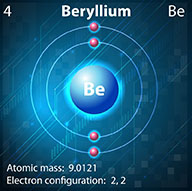
beryllium
Definition
Beryllium is a chemical element with the symbol Be and atomic number 4. It is a light, silvery-grey metal that is very strong and hard. Beryllium is not found naturally in its pure form, but it is found in small amounts in many minerals.
Beryllium is a very reactive element, and it can be toxic if it is inhaled or ingested. However, beryllium is also a very important element in many industrial applications. It is used in the manufacture of high-strength alloys, such as beryllium copper. Beryllium is also used in nuclear reactors and in the production of some electronic components.
How can the word be used?
Beryllium is a toxic metal, so it must be handled with care.

Different forms of the word
Noun:
beryllium (a chemical element with the symbol Be and atomic number 4).
Adjective:
beryllium (of or relating to beryllium).
Adverb:
berylliumly (in a beryllium way).
Etymology
The word "beryllium" comes from the Greek word "beryllos," which means "green gemstone." The name was first used in English in 1797 by the English chemist Sir Humphry Davy.
Question
What can beryllium be used for?
AQA Science Exam Question and Answer
Question:
Define the chemical element "beryllium," including its symbol, atomic number, and key properties. Describe one significant application of beryllium in real-world scenarios.
Answer:
Beryllium is a chemical element with the symbol Be and atomic number 4. It is an alkaline earth metal, located in Group 2 of the Periodic Table.
Beryllium is a lightweight, strong, and brittle metal with excellent thermal conductivity and a high melting point. Due to these properties, it is commonly used as an alloying agent in aerospace and defense industries.
One significant application of beryllium is its use in manufacturing beryllium-copper alloys. Beryllium-copper alloys are highly conductive and resistant to corrosion and fatigue, making them suitable for high-performance electrical connectors, springs, and switches in electronic devices, computers, and telecommunications equipment. Additionally, beryllium-copper alloys are used in the aerospace industry for components such as gyroscopes and other sensitive instruments due to their stability and precision performance. However, it is essential to handle beryllium and its compounds with caution, as they can be hazardous if inhaled or ingested, leading to a condition called berylliosis, which affects the lungs.